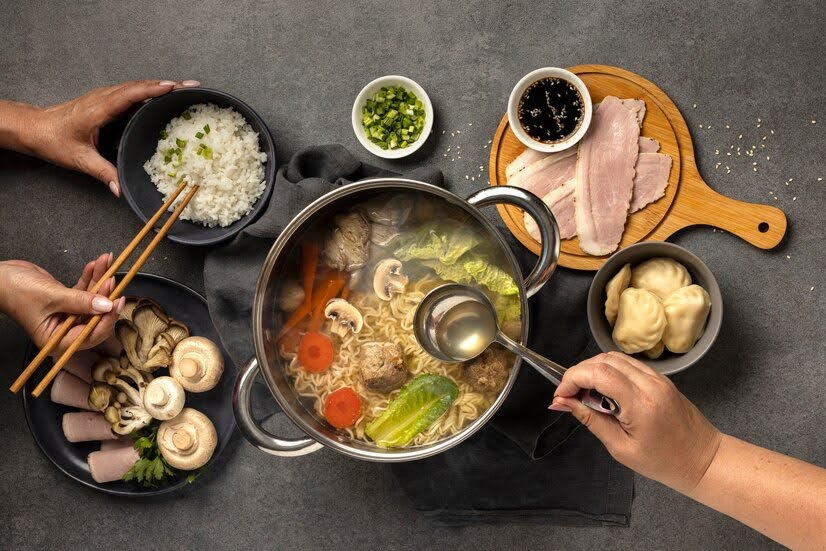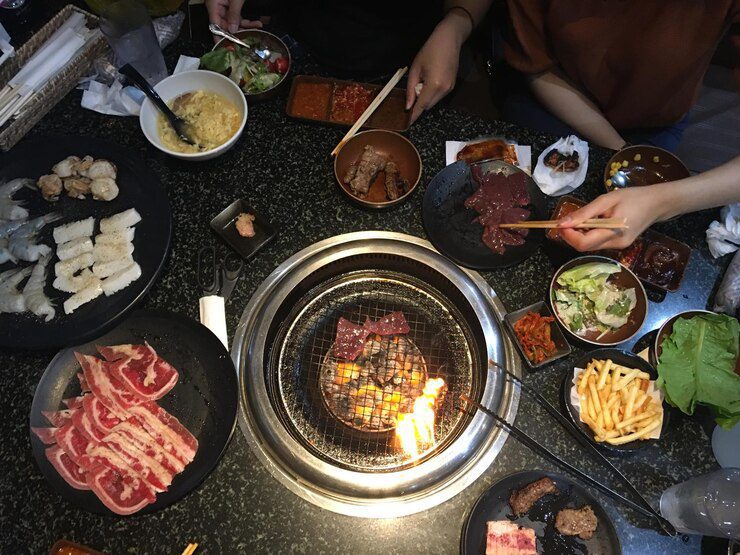
If you think Hot Pot is just a spicy soup, think again. China, one of the most culinarily diverse countries in the world, offers a rich tapestry of flavors through its hot pot traditions.
Different regions in China have mastered their own hot pot styles, each with unique flavors, expertly crafted broths, and a variety of ingredients.
From the fiery heat of Sichuan to the tropical tastes of Hainan, here are some of the most popular regional hot pot styles. Ready your chopsticks for a delicious adventure!
Types of Hot Pot
1. Sichuan Hot Pot
Chengdu, or Sichuan hot pot, stands out for its spicy and aromatic flavors, thanks to ingredients like Sichuan peppercorns, star anise, and citrus peel. The broth, rich and red, gets its intense flavor from simmering with pork bones.
You’ll find a variety of ingredients, including beef, pork, chicken, and offals like stomach and liver, alongside fresh vegetables, different types of tofu, and potato starch noodles. This combination with the spicy Chengdu broth creates a robust, distinctly Chinese flavor.
2. Yunnan Hot Pot
Here are the features of this type of chinese hot pot:
- Flavor Profile: Rich, umami, and slightly sour.
- Broth: Yunnan’s famous wild, rare, and exotic mushrooms make up the base of this broth. Sometimes, a touch of chili pepper is added for extra heat.
- Popular Ingredients: Expect fresh vegetables, various types of mushrooms, and edible flowers.
- Dipping Sauce: Sesame oil, chili oil, and mint are common in different dipping sauces. For an extra kick, cooked ingredients are often dipped in chili powder before eating.
If you lack inspiration to try a new hot pot, you just need to immerse yourself in the culture a little. You can try watching series on Peacock TV, even if you are in Canada, where the service is not available by default. It can be unblocked by VPN. And on to a new taste experience.
3. Beijing Hot-Pot
Beijing hot pot, also known as old Beijing copper pot to boil mutton, or simply boil mutton, is internationally dubbed Mongolian hot pot due to its shared origins. Unlike the spicy Sichuan hot pot, Beijing hot pot features a base soup with just water, sliced spring onion, and ginger, resulting in a lighter flavor. The main ingredient is mutton, earning it the name instant-boiled mutton. The distinctive copper pot uses charcoal for fuel and highlights the ingredients’ natural flavors. A classic dipping sauce made from sesame paste, vinegar, Chinese chive paste, fermented bean curd, soy sauce, minced coriander, chili oil, and minced Chinese leeks accompanies the dish.
4. Chaoshan Beef Hot Pot
Chaoshan beef hot pot, originating from the Chaoshan region (also known as Teoswa or Chiuchow) on the eastern coast of Guangdong Province, China, is a unique culinary experience. Unlike other hot pots, it uses a light beef bone broth or water base, emphasizing the natural flavors of high-quality beef. Each part of the cow is carefully selected and prepared, much like steak cuts, and cooked to perfection by adjusting the firepower, which is rare in other hot pots.
A signature feature of Chaoshan beef hot pot restaurants is the handmade beef balls, crafted by beating beef with a heavy gavel for over two hours to create a chewy, elastic texture. This meticulous process ensures that every bite delivers the ultimate tenderness and rich flavor.
5. Chongqing Hotpot
Chongqing is undoubtedly China’s hotpot capital, boasting over 20,000 hotpot restaurants and 50,000 franchises nationwide. The city’s hotpot is famed for its heavily flavored, numbing spiciness (málà 麻辣) and rich broth made with premium butter and red hot chili.
The origins of hotpot in Chongqing trace back to boatmen along the Yangtze River, adding to its cultural significance. Popular ingredients include fresh máodù (cow stomach), often paired with sesame oil dipping sauce to balance the heat. If you’re a hotpot enthusiast, Chongqing offers an authentic and unforgettable experience.

6. Hulunbeier Hot Pot
Hulunbeier hot pot offers a mild and smooth broth made from pork or chicken bones, lightly seasoned with soy sauce, salt, and a hint of pepper. This gentle flavor profile caters to those who prefer less intense tastes.
The hot pot is also known for its diverse ingredients, including a variety of seafood such as shrimp, clams, crab, and fish, alongside other meats like pork and chicken. Fresh vegetables add to the nutritional balance, making Hulunbeier hot pot a wholesome and complete meal choice.
7. Guilin Hot Pot
Guilin hot pot stands out for its unique, tangy flavor, thanks to its tomato-based broth. This broth combines fresh and dried tomatoes, dried chilies, fish sauce, and various herbs for a sweet and savory taste. Common ingredients include beef, pork, chicken, offals, fresh vegetables, tofu, and noodles, all of which blend beautifully into the broth, enhancing its rich, sweet, and sour profile.
8. Coconut Chicken Hotpot
Coconut hotpot restaurants have surged in popularity in China recently. The concept is straightforward but delicious. The main ingredients for Coconut Chicken hotpot are Hainan chicken and fresh coconut milk. Unlike Sichuan-style hotpots, this broth is free from butter or fatty oils, making it a healthier choice. You can even enjoy the hotpot base as a soup.
To elevate the flavor, a special dipping sauce made with soy sauce and freshly squeezed lime juice is served alongside.
Conclusion
When we think of Chinese food, hot pot is a must-try. While Sichuan or Chongqing hot pot, brimming with red soup and chilies, often comes to mind first, it’s not the only variety.
Sichuan and Chongqing hot pots are incredibly popular, known for their spicy, visually striking broths. However, hot pot has many regional variations across China, each offering unique flavors. Good news for those who can’t handle spice—there are plenty of non-spicy hot pot options available!

Share this Story
